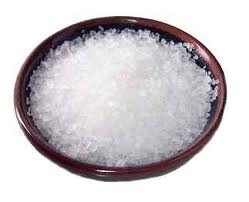 Sea salt, created by the evaporation of sea water, is used extensively in cooking. While more expensive than table salt, sea salt is becoming popular in both the United States and Europe. To make sea salt, an inland marsh is created which can be easily closed off from the sea. Once the sea brine enters the marsh, a large berm is created to assure the sea water does not escape. Next, the sun does the remaining work, evaporating the water and leaving behind the highly flavorful sea salt. The condensed salt is then raked into piles, and then milled to create a coarse grain. Since coastal brines can vary in color, there are many types and colors of sea salts to be purchased around the world. In Hawaii, black sea salt is a common type of sea salt. The most expensive and sought after form of sea salt is from France, named Fleur de Sel, or flower of the sea.
Sea salt, created by the evaporation of sea water, is used extensively in cooking. While more expensive than table salt, sea salt is becoming popular in both the United States and Europe. To make sea salt, an inland marsh is created which can be easily closed off from the sea. Once the sea brine enters the marsh, a large berm is created to assure the sea water does not escape. Next, the sun does the remaining work, evaporating the water and leaving behind the highly flavorful sea salt. The condensed salt is then raked into piles, and then milled to create a coarse grain. Since coastal brines can vary in color, there are many types and colors of sea salts to be purchased around the world. In Hawaii, black sea salt is a common type of sea salt. The most expensive and sought after form of sea salt is from France, named Fleur de Sel, or flower of the sea.
Key Nutrients
Sea salt is a great source of sodium. It can also be a great source of ocean based minerals such as calcium and iron, depending on the source of the sea salt.
Health Benefits
Sodium is an important mineral needed for cellular function, and positively benefits neural function.
Season
Sea Salt can be found in any supermarket or food retail store year round.
Nutrition Information
Per 1 teaspoon (6 grams):
Calories (cKal): 0
Protein (grams): 0
Total Fat (grams): 0
Carbohydrates (grams): 0
Fiber (grams): 0
Buying and Storing
When buying sea salt, make sure to buy it from a reputable supplier or supermarket. Being dry and having a low water activity, sea salt can store in a sealed container for up to three years.
Best Way to Add to Diet
Sea salt can be added to any recipe which calls for table salt. Simply substitute the table salt for your favorite type of sea salt.
Sea Salt Recipe
Smoked Salmon with Sea Salt and Shaved Fennel

 Not Sure What Healthy Foods To Eat?
Not Sure What Healthy Foods To Eat? This week we take a look at one of my favorite healthy foods...the mighty Avocado.
This week we take a look at one of my favorite healthy foods...the mighty Avocado.
No comments yet.